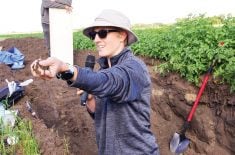Shelter belts vital | Wild bee population at risk?
INTERNATIONAL PEACE GARDEN, Manitoba-North Dakota border — Bulldozing a shelter belt can leave countless critters homeless.
And some of those birds and bugs play a crucial role in farming operations.
About half of agricultural crops rely on bees for pollination, said Mark Wonneck, an ecologist with Agriculture Canada in Calgary.
Many farmers use managed or domestic honeybees during the crop-growing season, but wild bees are also helpful pollinators.
Shelter belts provide ideal habitat for the many species of wild bees on the Prairies.
Read Also

Soybean market still figuring out implications of China-U.S. pact
Soybean futures had a muted reaction to the U.S. trade deal with China as the market tries to figure out the nuances of the deal.
“Seventy percent of wild bees are ground nesters and mostly solitary,” Wonneck told the Great Plains Windbreak conference this summer.
They nest several centimetres underground, under rocks or in gopher and mice holes. They need adequate pollen and nectar and protection from pesticides, which shelter belts often provide.
Bees who live above ground can choose old trees for their homes.
Wild bees typically stay close to their food sources, unlike domestic honeybees, which travel three kilometres from their hives and have been tracked as far as 14 km away.
Smaller wild species fly only 200 metres from their nests.
The most common wild bee, the bumblebee, is an efficient pollinator that lives in a quasi-colonial setting.
All the bees need access to food throughout their active seasons, and it’s common for them to travel from a canola field to the nest and back.
However, Wonneck said canola won’t do the trick all year. As well, canola doesn’t feed a lot of wild bees.
Bees need flowers from April to August, and not all flowers are equal from a bee’s point of view.
Fruit trees that flower early can help, and flowering shrubs within a shelter belt provide food outside the canola flowering window. Wonneck said incorporating shrubs in clumps within the windbreak could provide a buffet of flowers.
“We know very little about core habitat size: how big or how wide should a shelter belt be,” he said.
Pesticide use is common in farming operations but is detrimental to bees and shelter belts.
Wonneck recommended a buffer if possible between the area being sprayed and the shelter belt. He also said it is better for bees if aerial spraying is done when they’re least active.
“They’re like bankers,” he said to much laughter. “They’re out at 10 o’clock in the morning (and) they finish at three.”
The extent of the role of wild bee populations in crop pollination isn’t well known, he added, and there is no good data on the wild bee population.
For example, 80 to 95 percent of the landscape is cultivated in central Alberta, and large wild populations couldn’t possibly be maintained without habitat.
“Commodity canola is largely self-pollinating, and they say in the range of three percent to 20 percent of it could benefit from insects,” Wonneck said.
“In hybrid seed canola, they actually have male sterile plants and so they require insects to pollinate.”
He said farmers bring in 80 hives of honeybees per quarter at a cost of $150 per hive, plus leafcutter bees, to get the pollination job done.
The effect of this on wild bees also isn’t known.
Preliminary research data shows a relationship between the number of wild bees and the amount of habitat within 500 metres to one km of a field, but Wonneck said researchers don’t know how much managed honeybees suppress the wild bees.
















